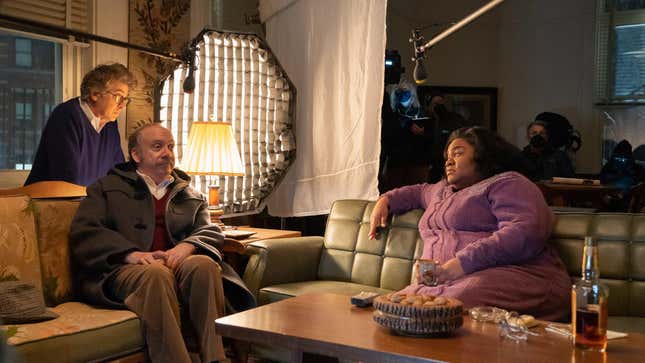
Christmas is coming early for cinephiles this year. The Holdovers, the long-awaited reteaming of classic comedy duo Paul Giamatti and Alexander Payne, rolls out in theaters nationwide on November 10, following a limited release at the end of October. Payne’s first starring vehicle for Paul Giamatti since 2004’s Sideways is a throwback dramedy straight out of the 1970s.
As ornery history teacher Paul Hunham, Giamatti and co-stars Dominic Sessa and Da’Vine Joy Randolph take audiences back to prep school. Set at Barton Academy, a Massachusetts-based boarding school, over Christmas break 1970, The Holdovers sees an intelligent teenage outsider, Angus (Sessa), stuck at school during the holidays with his least favorite teacher while his mom hits the ski slopes with her new husband.
Angus feels abandoned; all Holdovers do. Payne’s film, however, is as cozy as a wool sweater and a hot toddy. The movie also revels in its Nixon-era touches, which feel so authentic that they almost become another character on screen. Just don’t call the film a period piece.
“Let’s be clear,” Payne said during a recent conversation with the press about Holdovers, “it’s not just a period film. My collaborators and I gave ourselves the thought challenge experiment of time-traveling and pretending as though we were making a film shot in 1970 and ’71, and that the final film looks as though it might’ve been produced then. We’re making a contemporary film, pretending we’re in 1970.”
Pretending to be in 1970 while making a film in 2023 isn’t as easy as it sounds. But it did allow the filmmakers to be “banal and grimy ... as though we were making a low-budget film then,” Payne continued. He added that the film’s locations feel real and lived in because “change comes slowly” to New England. According to Payne, the Massachusetts setting offered the Holdovers crew a unique opportunity. Many of the locations were “pretty much as they fell off the truck,” the director said. “The candlepin bowling alley and the cafe where Ms. Crane works, they’re as is, kind of locked in time from the ’40s or ’50s.”
Still, the overarching approach to the film’s aesthetic is to avoid being perceived as a costume film, which becomes challenging when herding hundreds of high schoolers into a dining hall. “There’s so many people in this movie, there’s so many clothes, half of which don’t appear on the screen,” said costume designer Wendy Chuck. “But the volumes. I would look at my assistant, I’d say, we’ve got to find more clothes. I’d go down to where the background was being fit and say, we don’t have enough clothes.”

As a born-and-bred Massachusettsan, screenwriter David Hemingson was “amazed at how spot on, how incredibly consistent and how historically accurate” the costuming was. “It was this combination of stuff that was very traditional with stuff that would’ve been contemporary at the time,” he added. “That gave a tremendous verisimilitude to the costumes. Like, the fact that people were dressing like they would’ve actually dressed in the truest sense of the word.”
To make this fictional boarding school feel real, production designer Ryan Warren Smith needed to “dress every part of the set” regardless of whether it was in the script because they wanted to ensure the actors had room to live. These spaces say a lot about the characters, from the book on Paul’s nightstand (Fear Strikes Out, a biography of Boston Red Sox centerfielder Jimmy Piersall) to what’s on his desk. Smith and set decorator Marcus Whiteman would dress “Paul’s desk drawer or something that he’s not supposed to open” with period-appropriate objects, just in case Giamatti feels the call of the desk drawer.
That doesn’t mean all of it has to be period-specific. Smith revealed “a little Easter egg,” a statue from The Sideways set, hidden in Paul’s office. It’s one of two nods to an extended Alexander Payne-iverse in the film. Wendy Chuck admits, “Lydia Crane (Carrie Preston) wears a heart-shaped necklace (and) Reese Witherspoon wore the exact same one in Election.” Thankfully, the Payne-iverse doesn’t spend too much time on Easter eggs. Instead, The Holdovers is a warm, funny, and emotionally winning film about people.

While The Holdovers harkens back to a time before digital editing and filmmaking, Payne and editor Kevin Tent realized that their approach to the film’s construction didn’t need much fine-tuning. “Yeah, we used some dissolves,” Tent said. But he added that they “always use dissolves.”
“We love ’em, and we probably have a few more than we normally do,” Tent admitted. “When Paul is yelling at the kids in the beginning, and it dissolves to the hallway, we’ve done that before. So, we really approached the film how we always do and just let our performances drive our decision-making.”
That’s probably why The Holdovers feels so effortless. The places, characters, and situations feel biographical, as if they happened to a real person. It’s a credit to the light touch but rigorous attention to detail Payne and his crew perfected across production. However, some of it just came naturally. Payne realized during the interview that slipping into that ’70s atmosphere was so easy because he’s always been doing that.
“Our film language in the previous films is kinda the same,” Payne said. “The same transitional techniques we use, it’s just that perhaps they stand out more in this one because it’s purposely, you know, it has the parlor trick of trying to appear like it’s from the ’70s. But our film grammar, I think, is basically we’ve been making ’70s movies the whole time.”